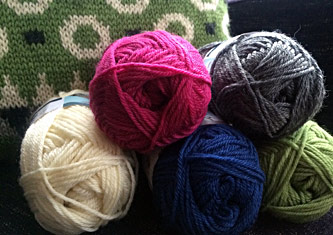
I won’t ask for a show of hands, but how many of you have looked at a knitting pattern, shrugged at the line that says, “Make a gauge swatch” and entrusted the fit of your knitting project to wild optimism? Are you part of the knitting population who closes their eyes, clicks their heels, and repeats, “I hope it will fit. I hope it will fit,”? Now, again no hands, how many of you have had to give away or donate clothes that you knit because the finished product was the wrong size ? Take heart, you don’t always have to knit a gauge swatch. When you do knit one, there is a lot of information you can glean from it that will help you improve your knitting skills overall, not just help you size a single project.

Knitting designer and Ingebretsen’s instructor Paul Robinson understands a knitter’s ambivalence about taking the time to make a swatch when starting a new project is so appealing. “If I am knitting a pattern and using the yarn that is suggested by that pattern, I do not check my gauge. I trust the author,” Paul says. “However, If I am using a different yarn weight or needle size other than what a pattern calls for, I check the gauge and update the pattern, mostly stitch and row counts.”
When Paul teaches a knitting class, he asks his students to knit test swatches. “It’s important for all knitters to connect and learn yarn weights and how they work with needle size,” he says. The Craft Yarn Council has developed a standardized system of yarn weights and suggested needles sizes (see video below for detailed information), but nothing beats knitting up different yarns on different needles and getting a sense of size, weight, and the feel of the fabric by knitting your own swatches.
(Note: You can go to 5:08 to go directly to the yarn weight and needle information.)
If Paul is designing a sweater and writing a pattern or if he is knitting on commission, he makes gauge swatches. “It is important to me that I know that the yarn, the needles, and my tension are working togethers to create a beautiful product. With this I carry color, cable, and do different ribbings or other techniques that I might be doing in the pattern.” So, while diving into a new project and hoping for the best is understandable, making swatches helps you better predict what your finished knitwear will look and feel like.
Unless you had a very thorough knitting teacher or a particularly good knitting book, the “how” of using a gauge swatch, especially to determine the number of stitches per inch, is rarely explained. Below is a video which details how to use your swatch once you’ve knitted it and what to do if your stitches-per-inch don’t match the pattern requirements. (Hint: It’s not throwing your yarn and needles across the room.)
Please share your thoughts on knitting a gauge swatch and feel free to share any stories of gauge-gone-wrong. Knitters are quick to commiserate and to slightly paraphrase Red Green, we’re pullin’ for ya.
I am a believer in swatches! While I used to think I knit right on the mark, I learned last year doing an independent pattern that it really depends on the writer. It was a stranded mitten, and I had to go down to 00 needles to get it to size. Now I swatch everything, to build up a little more data for my personal use! Thank you for these video links!